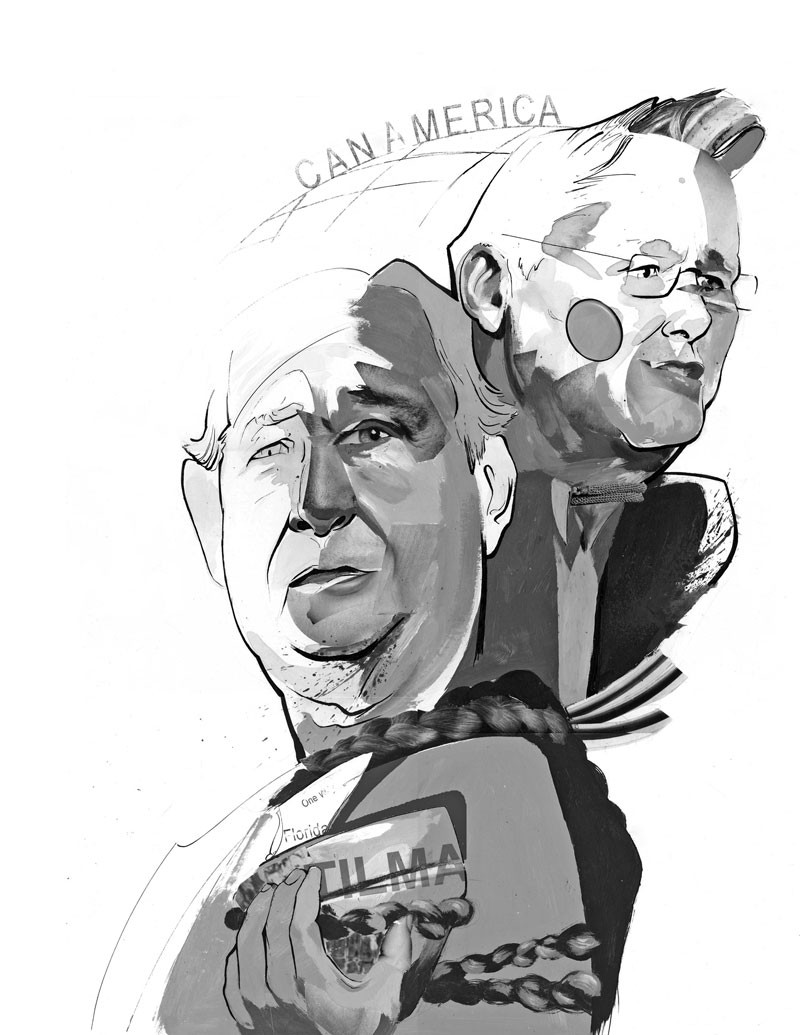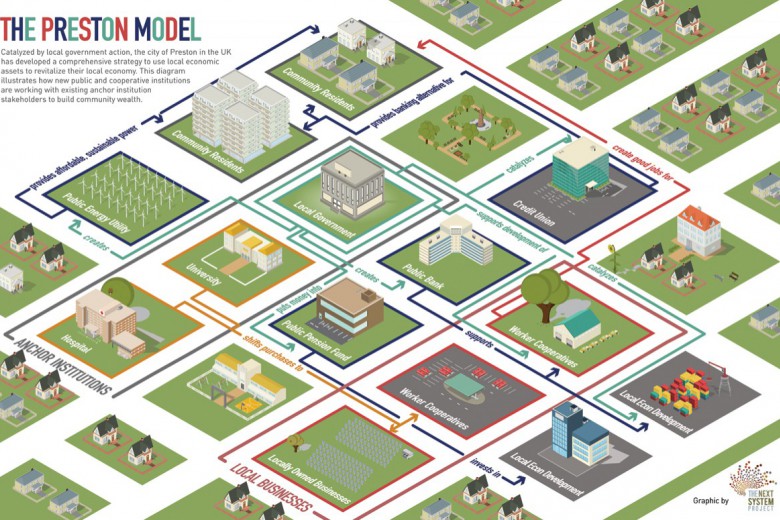
Canada’s most ideologically right-wing provincial governments have joined forces in an agreement that erodes their own powers – and now they are trying to sell other provinces on the deal. Ellen Gould argues that the rest of Canada would be well-advised to reject the deal as an attack on their very right to govern.
On a CBC radio show in October, British Columbia’s Minister of Economic Development Colin Hansen and Alberta’s Minister of Intergovernmental Affairs Gary Mar boasted about how Saskatchewan was keen to sign on to TILMA, the BC/Alberta Trade, Investment, and Labour Mobility Agreement. This agreement, which goes far beyond existing trade agreements, was signed by British Columbia and Alberta in April, 2006, after zero consultation with the general public. The agreement will come into effect in April, 2007.
The pitch Hansen and Mar made for TILMA sounded great. Through TILMA, BC and Alberta will form an economic powerhouse second only to Ontario. _ The agreement will get rid of “huge” inter-provincial trade barriers so that, rather than focusing on increasing international trade, Canadians will be able to trade more with other Canadians. _(Yeah, Canada!) And TILMA will standardize professional requirements so that people can leave home with their qualifications and be accredited to work in the other province. (Yeah, labour!)
So why shouldn’t Saskatchewan rush to sign on? Because what TILMA does is force governments at both the provincial and local levels to surrender vast areas of their ability to govern. The agreement is essentially a long list of things governments will be prohibited from doing, regardless of whether they are acting completely within their jurisdiction. Even if a majority of citizens in a province are demanding a new government initiative, the government will be blocked from acting if the initiative would conflict with TILMA. TILMA enables private investors to challenge governments, allowing commercial interests to trump the public good.
If anyone in the provincial government does due diligence and seriously investigates the case being made for TILMA, they will find it is a house of cards.
The Western Canada boosterism used to sell the agreement is a sham: BC Premier Gordon Campbell was lobbying Ontario Premier Dalton McGuinty to sign on even as TILMA was being sold as a way to assert Western Canadian economic ascendancy over Ontario.
The claims of “huge” inter-provincial trade barriers also turn out to be based on nothing, or next to nothing—-some isolated examples of trade irritants and a 1991 Canadian Manufacturers� Association report that confuses international with inter-provincial trade barriers. And all the labour mobility aspects of the agreement will soon be achieved by a separate process initiated by Manitoba’s Premier Gary Doer.
A study done for the BC government in the late 1990s pointed out that trade barriers among the provinces are actually very low, meaning that, contrary to the recent claims of Hansen and Mar, “efforts to liberalize inter-provincial trade will have almost no effect on inter-provincial trade flows.” Any projections of TILMA-related economic growth are, consequently, iffy at best. The agreement is certain, on the other hand, to result in deregulation, private sector challenges to government programs and policies, and the termination of economic development initiatives.
Far from being a recipe for prosperity or a stronger Canadian union, this agreement in fact represents a major step towards deep integration with the US—-the process of harmonizing Canadian and US policies and regulations.
More Extreme than NAFTA and the Agreement on Internal Trade
Some of the most draconian provisions in TILMA can already be found in a 1994 agreement all provinces and the federal government are party to: the Agreement on Internal Trade. For example, both TILMA and the Agreement on Internal Trade state flatly that there shall be “no obstacles” to trade, investment, and labour mobility. They both say that provincial regulations are to be made the same, undercutting the democratic right of citizens to elect provincial governments that will bring in higher standards than exist in other provinces.
So why, if the already-signed Agreement on Internal Trade is so radical, have so few Canadians heard about it? Because it is mostly voluntary, allowing governments to harmonize their regulations gradually. If private investors think the agreement is being violated, they have to lobby their provincial governments to pursue complaints on their behalf. A government can block a private investor’s complaint if they do not believe it is based on a reasonable interpretation of the agreement. Dispute panels cannot award monetary compensation for any violations.
The handling of disputes is one of the major differences between TILMA and the Agreement on Internal Trade. TILMA gives private investors, including persons who hold shares in a company and companies seeking to make new investments, new rights to challenge governments on a variety of grounds, including over programs and regulations that “impair or restrict” their investments.
The implications of these TILMA provisions are staggering. What government program or regulation could not be seen as a restriction on private investment? Saskatchewan’s Crown Corporations, for instance, certainly restrict private investment by providing services that might be supplied in the private sector. Regulations such as municipal restrictions on the ability of developers to knock down heritage buildings clearly impair the ability of investors to maximize the return on their property investment.
Saskatchewan’s Heritage Property Act could, therefore, become an early casualty of a TILMA-bound Saskatchewan. Among other things, the Act empowers municipalities to designate both individual properties and districts as heritage spaces, requiring property owners to seek municipal approval before making changes to such properties. The official legislative objective is to provide for “the Preservation, Interpretation and Development of Certain Aspects of Heritage Property.” Saskatchewan’s heritage legislation could be attacked through TILMA as a restriction on investment that cannot be justified under the agreement as meeting “legitimate” objectives.
TILMA is in fact more dangerous than NAFTA in its threat to governments. Already, NAFTA suits launched by private investors have meant that Canada has had to pay millions of dollars in compensation because it refused to export PCBs (which would have been a violation of its international environmental commitments). And the Canadian government is now in danger of losing a NAFTA challenge to Canada Post launched by UPS, the American parcel delivery firm. Less obvious is the damage done by the “chill effect” from the threat of investor lawsuits under NAFTA, such as when the federal government backed away from requiring plain-paper packaging of cigarettes or when Ontario and New Brunswick were dissuaded from introducing public auto insurance.
TILMA, however, goes even further than NAFTA in creating legal jeopardy for governments. The grounds that private investors can sue over are limited in NAFTA to clauses in Chapter 11 (investment) and Chapter 15 (state enterprises). In contrast, a private investor can take a government to a TILMA dispute panel over “any matter regarding the interpretation or application of this Agreement” (emphasis added).
TILMA sets a $5 million cap on the compensation that panels can award in a single case. But since there is no restriction on the number of challenges that can be launched about the same program or regulation, governments will face continuous challenges if they keep doing anything that has been found to violate the agreement.
For example, an outdoor advertising firm might launch a TILMA case against a municipality’s ban on billboards, and get as much as $5 million depending on the amount of business it had lost or would lose in the future. Once the proceedings in that case were over, though, another advertising firm could bring forward another case over exactly the same municipal billboard ban, and again get as much as $5 million in compensation. The cases could go on indefinitely until the municipality changed its bylaws and allowed unrestricted billboard advertising. TILMA goes far beyond NAFTA in providing grounds for such lawsuits against standards and regulations.
Another worrisome difference between NAFTA and TILMA is how the two agreements treat public services. Canada negotiated an exception in NAFTA to be able to adopt or maintain any measure related to social services, with education and healthcare specifically mentioned. While this NAFTA exception has been criticized as weak, TILMA is even worse in that it only contains exceptions for social policy, not social services. A panel might interpret this difference in terminology between the two agreements as an indication that TILMA’s negotiators did not intend to protect public services.
One of TILMA’s frequently quoted supporters, Todd Hirsch of the Canada West Foundation, told the Globe and Mail in November that with all its special rules and caveats, “no one really has a good handle” on the agreement. So TILMA’s boosters seem to be advocating that despite its uncertainties, provincial governments should just go ahead and sign the deal and hope for the best. Needless to say, any lawyer advising a business to take this “sign first, consider the consequences later” approach to a legally binding contract would be fired.
“Everything Canadian business asked for”
For whatever reason, the BC and Alberta governments have created a litigant�s heaven in TILMA, enabling private investors to sue them with the greatest of ease. The speed with which private investors can get a TILMA complaint heard, receive a panel ruling, and then be awarded monetary compensation would seem ideal from the perspective of someone wanting to challenge government programs and regulations. The short timelines TILMA imposes “forty-five days to issue a report, fifteen days to produce requested clarifications” mean that the cost of suing under the agreement would tend to be cheap relative to domestic courts or NAFTA.
Because modern day trade disputes have wider implications than just narrow commercial issues, panel rulings should be of great concern to the general public. Recent trade panel rulings have decided critical questions such as whether a country can maintain a moratorium on the introduction of genetically modified foods and whether alcohol advertising can be banned. But the time limits TILMA imposes on panels only encourages snap judgments on complex and far-reaching issues. The insistence that panels rule on the fate of government programs and regulations under such time constraints makes you wonder just whose interests the agreement is intended to serve.
Actually, you don�t have to wonder. Alberta minister Gary Mar revealed to a Richmond Chamber of Commerce audience that TILMA’s dispute process was “everything Canadian business asked for.”
What’s good for Alberta…

Heather Douglas, President of the Calgary Chamber of Commerce, has praised the Alberta government’s role in negotiating TILMA, saying it “acted on our suggestions.” According to Douglas, if Alberta signs TILMA-like agreements with other provinces, businesses will benefit from increased deregulation across the country. Paraphrasing the old saying about General Motors, Douglas promotes TILMA on the basis that “what’s good for Alberta will be good for the country.”
TILMA requires provinces to “reconcile their existing standards and regulations that operate to restrict or impair trade, investment or labour mobility.” Given Alberta’s deregulated environment, that means any province signing on to TILMA will have to adopt Alberta’s lower standards and regulations, since anything higher could be challenged as a restriction on investment. Only regulations covered by the agreement’s exceptions would not be affected.
Once provinces have deregulated to the same extent as Alberta, the text of the agreement states that signatory provinces will be prevented from introducing “new standards or regulations that operate to restrict or impair trade, investment or labour mobility.” So higher standards adopted in the future, such as the ones Manitoba is considering to control hog barns, would likely be ruled a TILMA violation. To add insult to injury, if a province does ever entertain the idea of raising its standards, TILMA legally obligates it to seek the opinion of the other provincial governments and to take their views into consideration.
In obligating provinces to harmonize their regulations, TILMA deletes a key safeguard in the Agreement on Internal Trade, which says: “The Parties shall not, through such harmonization, lower the levels of environmental protection.” The fact that TILMA contains no such clause is just what you would expect in an agreement drafted with no input other than from business interests.
The limits of TILMA safeguards
TILMA’s advocates have pointed to its list of exceptions and its “legitimate objectives” clause in order to dismiss concerns about the agreement. TILMA does have a list of policy areas that are exempt, such as government measures related to water, aboriginal peoples, and social assistance, but these are subject to annual review “with a view to reducing their scope.”
Saskatchewan may take the advice of trade officials that it can sign the agreement but still protect key areas of provincial policy by registering exceptions. This is a risky venture, however, since TILMA assumes that everything is covered except for those areas that negotiators think to exclude. For example, BC’s negotiators did not register an exemption for the province’s Agricultural Land Reserve, which limits urban development to preserve agricultural land. Such legislation seems tailor-made for a TILMA challenge.
BC officials are claiming, however, that regulations like the Agriculture Land Reserve could be protected in the event of a challenge by TILMA’s “Legitimate Objectives” provisions. These provisions allow for violations of the agreement only if government regulations can meet certain criteria. First of all, they have to show that the program or regulation under consideration is intended to achieve objectives defined in the agreement as “legitimate,” such as public order or protection of the environment. There are obvious omissions from the list of legitimate objectives, such as food security or the preservation of heritage properties.
Getting a panel to acknowledge a given objective as legitimate, however, is the least of a government’s worries. If challenged, they have to prove their regulations are “necessary,” which is a very tough standard in trade law.
In fact, we know exactly how difficult it would be for governments to defend themselves with TILMA’s legitimate objectives provisions because an Agreement on Internal Trade panel has already ruled on such provisions. In the case against the federal government’s ban on inter-provincial trade of the gasoline additive MMT, the Agreement on Internal Trade panel accepted that the federal government had a legitimate reason for its regulations. But the MTT panel ruled that because the “Legitimate Objectives” provisions of the Agreement on Internal Trade require that whatever a government does to meet its objectives cannot be “unnecessarily” restrictive, the burden of proof falls on the defending government “to demonstrate that no other available option would have met the legitimate objective.”
The TILMA advocates who are so sure that the agreement’s “Legitimate Objectives” provisions will protect valued public policies should be challenged to name any policy that would be safe if a government had to demonstrate it had no other “available option.”
Ending support for economic development initiatives

Alberta has been praised at the WTO for legislating a ban on assistance to private businesses. This Alberta policy is entrenched in TILMA’s prohibition of business subsidies that “distort business decisions”—-which could be said of any business subsidy. An example of a possible violation is Saskatoon’s support for businesses located in economically depressed neighbourhoods. In defined “Enterprise Zones,” Saskatoon provides tax breaks and waives permit fees for businesses. This assistance would fall under TILMA’s definition of prohibited business subsidies, which includes not only cash grants but also any “reduction in taxation…or government levies otherwise payable.” As well, TILMA only permits regional economic development initiatives under “exceptional circumstances.” So, for instance, the commercial loans Saskatchewan grants to northern business under the Northern Development Fund would be TILMA violations.
TILMA also contains harsh restrictions on government procurement, ensuring that it can never be used to foster local or ethically minded businesses. Purchases of goods costing as little as $10,000 have to conform to rigorous guidelines to guarantee that no preference will be granted to local suppliers. TILMA’s procurement rules will apply not only to provincial governments, but also to municipalities, school boards, and even non-governmental organizations that have regulatory or supervisory authority granted by governments.
The domino approach to trade negotiations
The Alberta government has for many years been pushing other provinces to approve a TILMA-like transformation of the Agreement on Internal Trade. By striking this deal with the neo-liberal government of BC, Alberta is taking a page from the US Trade Representative’s playbook. When US trade negotiators have been blocked in achieving their agenda through multilateral negotiations on such agreements as the Multilateral Agreement on Investment, the Free Trade Area of the Americas, and the latest round of WTO negotiations, they have shifted their focus to negotiating bilateral deals with the low hanging fruit: governments vulnerable to US pressure or unconcerned about the loss of their right to regulate. Eventually, with enough such agreements in place, hold-out countries will face increasing pressure to sign on. Similarly, if other provinces begin to sign on to TILMA, pressure will grow on non-signatories to join the club.
TILMA and the US bilateral deals have a number of very similar elements: they provide expanded rights to private investors to sue over government regulations and programs; they contain strict constraints on local preferences in government purchasing; and they put the burden of proof on governments to demonstrate their regulations are “necessary.” Both TILMA and bilateral agreements are being promoted as establishing precedents for future deals that would involve many more signatories.
Standing up for the right to govern
There is nothing inevitable, however, about this trade encroachment into more and more areas of public policy. A majority of state governments in the US have resisted the US Trade Representative’s pressure tactics and have taken action to limit their vulnerability under new trade agreements. Some examples of state initiatives are:
A number of states have declared they will not be bound by procurement rules in new trade agreements because this would require state-funded jobs to be outsourced. Oregon�s Governor made it clear in a 2004 letter to the federal government that “neither the United States government nor any other government should consider Oregon a voluntary participant in any new trade pacts with regard to state procurement practices.”
When the WTO negotiations on services were heating up in 2006, the Governor of Maine wrote the US Trade Representative to express concern about the threat to critical state programs, including Maine’s healthcare initiatives. The Governor wrote: “Maine cannot sit idly by and let the federal government negotiate trade agreements that undermine public services, good paying jobs, and our ability to make our own decisions at the state and local level.”
Attorneys general of 29 states wrote to the US Trade Representative in 2005 to say their states opposed the negotiation of new WTO restrictions on regulations—-restrictions that are strikingly similar to those included in TILMA—-because they would “unacceptably encroach upon our states’ regulatory authority.” The states succeeded in getting the US to oppose the new restrictions.
We are so accustomed to looking askance at US state governments and their weak social programs that it is hard to imagine that they might have something to teach us. But our provincial governments, which are no more conservative than the US states mentioned above, would do well to follow their lead in defending their authority to act in the public interest. They can start by unequivocally rejecting TILMA.
Ellen Gould is a consultant who has advised local governments, consumer groups and other organizations on the potential impacts of trade agreements.
To start your subscription immediately, call (306) 525-2949, email us, or subscribe online.






